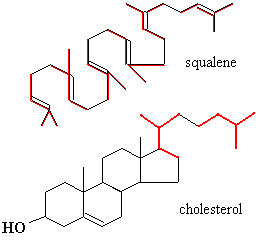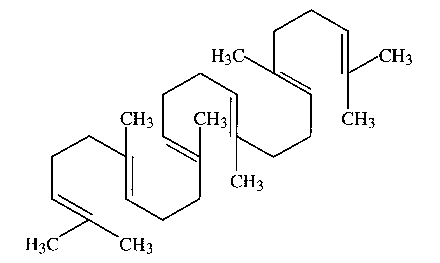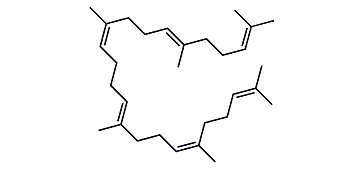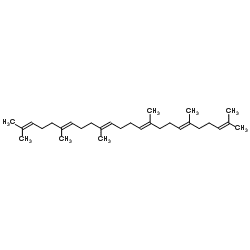3DMet B00166 Molar mass 410.718 g/mol | Formula C30H50 Density 858 kg/m³ | |
 | ||
Appearance Pale yellow, translucent liquid | ||
Organic chemistry alcohol acid catalysed cyclization of squalene oxide tutorial
Squalene is a natural 30-carbon organic compound originally obtained for commercial purposes primarily from shark liver oil (hence its name, as Squalus is a genus of sharks), although plant sources (primarily vegetable oils) are now used as well, including amaranth seed, rice bran, wheat germ, and olives. Yeast cells have been genetically engineered to produce commercially useful quantities of "synthetic" squalene.
Contents
- Organic chemistry alcohol acid catalysed cyclization of squalene oxide tutorial
- Role in steroid synthesis
- Biosynthesis
- Interactive pathway map
- Shark squalene
- Derivative used as a skin moisturizer in cosmetics
- Use as an adjuvant in vaccines
- Health controversy
- References

All plants and animals produce squalene as a biochemical intermediate, including humans. It occurs in high concentrations in the stomach oil of birds in the order Procellariiformes.

Squalene is a hydrocarbon and a triterpene, and is a natural and vital part of the synthesis of all plant and animal sterols, including cholesterol, steroid hormones, and vitamin D in the human body.

Role in steroid synthesis

Squalene is the biochemical precursor to the whole family of steroids. Oxidation (via squalene monooxygenase) of one of the terminal double bonds of squalene yields 2,3-squalene oxide, which undergoes enzyme-catalyzed cyclization to afford lanosterol, which is then elaborated into cholesterol and other steroids.

Squalene is an ancient molecule. In plants, squalene is the precursor to stigmasterol. In certain fungi, it is the precursor to ergosterol. However, blue-green algae and some bacteria do not manufacture squalene, and must acquire it from the environment if they need it.
Biosynthesis
Interactive pathway map
Click on genes, proteins and metabolites below to link to respective articles.
Shark squalene

Squalene is a low density compound often stored in the bodies of cartilaginous fish such as sharks, which lack a swim bladder and must therefore reduce their body density with fats and oils. Squalene, which is stored mainly in the shark's liver, is lighter than water with a specific gravity of 0.855. Recently it has become a trend for sharks to be hunted to process their livers for the purpose of making squalene health capsules. Environmental and other concerns over shark hunting have motivated its extraction from vegetable sources or biosynthetic processes instead.
Derivative used as a skin moisturizer in cosmetics
Squalene is one of the most common lipids produced by human skin cells. It is a natural moisturizer, and occurs as a major component of nasal sebum.
Squalane is a saturated form of squalene in which the double bonds have been eliminated by hydrogenation. Squalane is less susceptible to oxidation than squalene. Squalane is thus more commonly used than squalene in personal care products, such as moisturizers.
Toxicology studies have determined that in the concentrations used in cosmetics, both squalene and squalane have low acute toxicity, and are not significant human skin irritants or sensitizers.
Use as an adjuvant in vaccines
Immunologic adjuvants are substances, administered in conjunction with a vaccine, that stimulate the immune system and increase the response to the vaccine. Squalene is not itself an adjuvant, but it has been used in conjunction with surfactants in certain adjuvant formulations.
An adjuvant using squalene is Novartis' proprietary adjuvant MF59, which is added to influenza vaccines to help stimulate the human body's immune response through production of CD4 memory cells. It is the first oil-in-water influenza vaccine adjuvant to be commercialized in combination with a seasonal influenza virus vaccine. It was developed in the 1990s by researchers at Ciba-Geigy and Chiron; both companies were subsequently acquired by Novartis. It is present in the form of an emulsion and is added to make the vaccine more immunogenic. However, the mechanism of action remains unknown. MF59 is capable of switching on a number of genes that partially overlap with those activated by other adjuvants. How these changes are triggered is unclear; to date, no receptors responding to MF59 have been identified. One possibility is that MF59 affects the cell behavior by changing the lipid metabolism, namely by inducing accumulation of neutral lipids within the target cells. An MF59-adjuvanted influenza vaccine (Fluad, developed by Chiron, which contains about 10 mg of squalene per dose) has been approved by health agencies and used in several European countries for seasonal flu shots since 1997. An influenza vaccine using MF59 as an adjuvant has been approved for use in the US in those 65 years of age and older, beginning with the 2016-2017 flu season.
A 2009 meta-analysis assessed data from 64 clinical trials of influenza vaccines with the squalene-containing adjuvant MF59 and compared them to the effects of vaccines with no adjuvant. The analysis reported that the adjuvanted vaccines were associated with slightly lower risks of chronic diseases, but that neither type of vaccines altered the rate of autoimmune diseases; the authors concluded that their data "supports the good safety profile associated with MF59-adjuvanted influenza vaccines and suggests there may be a clinical benefit over non-MF59-containing vaccines".
Health controversy
There have been attempts to link squalene to Gulf War Syndrome mainly due to the idea that squalene might have been present in an anthrax vaccine given to some military personnel during the 1991 Persian Gulf War. Studies found that deployed Persian Gulf War Syndrome patients are significantly more likely to have antibodies to squalene (95 percent) than asymptomatic Gulf War veterans (0 percent; p<.001). The first of these published results concludes with the following statement: "It is important to note that our laboratory-based investigations do not establish that squalene was added as adjuvant to any vaccine used in military or other personnel who served in the Persian Gulf War era." The second publication, however, links the incidence of anti-squalene antibodies and Gulf War Syndrome to five specific lots of vaccine. Furthermore, they cite results of 1999 testing by the U.S. Food and Drug Administration which found these specific lots of vaccine to contain squalene. In response to these results, a committee of the US Institute of Medicine stated that "The committee does not regard this study as providing evidence that the investigators have successfully measured antibodies to squalene", since the authors did not perform the normal scientific controls needed to show that their test was specific to anti-squalene antibodies. It has also been determined that the anthrax vaccines given to those US military personnel did not use squalene as an adjuvant. The vaccines were also tested for squalene, and none was detected with standard methods. Another method found no squalene in 37 of the 38 lots tested. One lot contained traces of squalene, at less than ten parts per billion, which is about one-thirtieth the level found in human blood. The FDA stated that this trace of squalene probably came from a fingerprint, since the oils on human skin contain enough squalene to send these extremely sensitive tests "off the chart".
A later study reported that about one in ten people have squalene antibodies in their blood, regardless of whether or not they received squalene from a vaccination. A later study confirmed this result, and also showed that vaccination with squalene-containing vaccines do not alter the levels of these naturally-occurring antibodies. A third study showed that these naturally-occurring antibodies were no more common in Gulf war veterans than in the general population.
Oil-water suspensions, including MF59, were associated with the ability to induce lupus autoantibodies in non-autoimmune mice. In one study, endogenous squalene was linked to autoimmune arthritis in rats. An epidemiologic analysis of safety data on MF59 seasonal and pandemic influenza vaccines showed no evidence of increased risk of vaccine adverse events of potential autoimmune origin.
The World Health Organization and the US Department of Defense have both published extensive reports that emphasize that squalene is a chemical naturally occurring in the human body, present even in oils of human fingerprints. WHO goes further to explain that squalene has been present in over 22 million flu vaccines given to patients in Europe since 1997 and there have never been significant vaccine-related adverse events.
